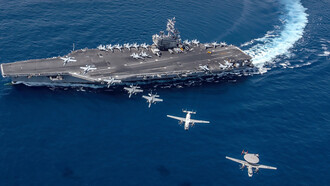Dedicated to the memory of Raoul Weiler (1938-2019) member Club of Rome, officer in the World Philosophical Forum, recipient of the International Gusi Peace Prize and holding Top Earth civil status as Citizen of the Earth-XXI. His life and work will be celebrated during the 10th Anniversary of the World Philosophical Forum, October, 2019, Athens.
- Nature is a creative artist; but art is not accident or arbitrariness, but the fulfilment of great laws… Civilization could not have evolved, nor can it survive, without an adequate food supply… Social justice means adequate food for all mankind
- The future will not be a comfortable hammock in which we will be waited upon by our robot slaves… we fool ourselves thinking we have our technologies firmly under control
Weather forecasting covers local to global conditions on a day-to-day basis and is accurate over several days to a high level of probability. It got underway in ancient times as well as in modern times not far from the Black Sea with observations on local precipitation and temperature. Climate change can span decades, centuries, millennia and is occurring within the here and now. It occurs on different time scales. Both weather and climate change use big data systems to handle the volume of data and multitude of variables to predict weather patterns and to model changes resulting from the onslaught of hurricanes, fires, and floods that affect mountain and tropical forests and everything else from rising sea levels to agriculture, wildlife, storm patterns, shrinking ice sheets, droughts, and human populations. Deforestation and lowered crop yields can occur. Questions asked are, will trees be shorter, fewer? Will there be less diversity and fewer species? Will carbon products overwhelm us all? We have seen exhausted polar bears sliding across the melting ice and we here about potential failure of the coffee culture sometime in the future. Science indicates that 1 million species are threatened with extinction.
A century ago the boy, Vladimir Koppen was fascinated by weather which lead to the Koppen-Geiger climate classification1. Later work built on observed and projected climate shifts depicted by his world maps. John Hansen developed approximate global climate models that give some indication of how carbon dioxide accumulation will drive planetry warming in the future. More recently he became an activist to mitigate effects of global warming, and on occasion has been arrested. The UK Parliament just made history to become the first one to declare an environmental and climate emergency. In parallel, Westminster Abbey hosted a thanksgiving service to mark 50 years of UK possession of at-of sea nuclear weapons systems.
The Black Sea coast provided Vladimir Koppen with a fertile field for youthful exploration while trips North and South gave him the idea that latitude controls growth of vegetation. He thought that the Moon influenced the cycle of sunspot activity as well as the Earth’s weather. In pursuing the phenomena of periodicity in weather patterns (meteorology) he collected considerable data on rainfall, temperature, wind, and barometric pressure; daily, weekly, monthly and annually. Köppen's grandfather and father were respectively, experts in public health and botany; Rudolf Geiger’s brother Hans co-invented the Geiger counter.
Somewhere-sometime, then, now, tomorrow, one or more of the horses of the Apocalypse, have galloped, are galloping, or will gallop over the land at enormous cost to peoples and their society; disease, pestilence, famine, war. In 2011, drought in Somalia caused over 250,000 deaths from hunger. Today in 2019, disease and famine hold the Yemen, Sudan, the Horn of Africa and Bangladesh in hostage, death of Rohingva Muslims is ignored and War in Syria continues; Ebola now threatens the Congo and malaria marches on, worldwide. In parallel, climate change, charges forward, as Arctic ice melts away, coastlines push inland and cities sink while the world of the big business sees profit oriented opportunity for oil, gas, rare minerals and pharmaceutical development. In parallel, the protective policy systems directed to commercial trading schemes to reduce greenhouse gas emissions seem themselves, open to commercialization. Imagine a world with as many as one billion people facing harsh climate change impacts.
What will millions of vulnerable people do this day to find adequate nutrition and water for their families? What will refugee mothers do tonight to feed their children? In the creeping new poverty what is the discrepancy between nutritional needs and actual consumption? In the world equation the number of food calories produced is significantly more than the quantity needed to feed the current global population. So, what fault lines exist in the food chain now? Over eating and obesity, waste and poor delivery are two issues to begin with. What will happen in the future if human and animal habitats slowly disappear and their natural or organized food supply fail? One answer to our question is through reducing existential threats, developing effective policy, utilizing science and technology, supported by new concepts of security, humanitarianism and philosophy.
Today, there is an adequate production of food to feed the world if it could only be distributed and equally consumed. While the world burgeons with excess food, 20 million people are on the brink of famine, millions of children still suffer from stunting and 1.4 million children are at imminent risk of death. Children lacking proper nutrition have a diminished ability to grow, to learn, and with age, to earn a living. The international community, governments and high profile personalities cannot rest until these children are reached, until every child has a fair chance to live and learn and grow into a healthy, productive adulthood.
As a start and with respect to food security, why can’t we in 2019 avert-avoid preventable catastrophe? Famine is a rare specific state and is characterized as a creeping disaster. It is declared based on three specific criteria: when one in five households in a certain area face extreme food shortages; more than 30 percent of the population is acutely malnourished; and at least two people for every 10,000 die each day. Arif Husain chief economist for the World Food Program says that bad things have already happened when a famine is declared; people have already died.
Tomorrow, how to feed the world is a thorny question. It has been an agenda item in the World Philosophical Forum, Athens and during a recent International Round Table on Peace and Democratic Multilateralism, Belgrade. José Graziano da Silva, FAO, has argued that the knowhow of indigenous peoples is fundamental to the global fight against hunger, food insecurity and poverty. On the one hand their ancestral knowledge has produced good practices while they have been deprived of rights and in the management of natural resources.
How to Feed the World in 2050 was discussed in Rome in a High Level Expert Forum more than a decade ago. The persistent and challenging demands on agriculture are to produce more food and fibre to feed a growing population with a smaller work force, to ensure more feed-stocks for a huge bioenergy market in the many agriculture-dependent developing countries with agriculture an engine of development. Consequently, it must adopt more efficient and sustainable production methods while adapting to climate change. In this article the time line is stretched to 2100.
Recently, I listened to erudite but troubling talks (Athens and Belgrade) on Food scarcity and its unavoidability by the year 2100. It was based on a report to the European Academy of Sciences and Arts, Salzbourg. In Athens the talk was given during the 8th Dialectical Symposium, of the World Philosophical Forum (WPF) by Raoul A. Weiller, member of the Club of Rome and a recipient of the International Gusi Peace Prize. He suggested that a World Governance Body for Food Availability be created2. I was privileged to be given a book of the same title by the author, a slim book, chock a block with valuable information.
Hector Gurgulino de Souza & Winston Nagan, President and Chairman of the Board of Trustees World Academy of Art and Science say that it is a profoundly good study worthy of the widest distribution in public policy circles as well as public opinion Fora. The work presented by Weiller dealt with an exceedingly complex issue and should be seen as a sequel to Limits to Growth of the Club of Rome several decades on. In contrast, it is not limited to description and evaluation of threatening global developments but takes a more solution oriented approach. Its focus is how to avoid future hunger, which has the potential to precipitate societal upheaval with massive social unrest and political instability.
Raoul A. Weiller’s book summarises a lengthy, in depth study in which the time course of food production is projected into the future. Its global range spans 25 earth climate zones and examines their background of climate change and growing population. A somewhat different understanding of the ill-distribution of the quality of life on earth emerges, otherwise referred to as global inequality. From it emerges an urgent need to restructure the international community, which is a current topic of intense discussion in many Fora. It is yet another cautionary alarm, signalling how close we are to planetary demise as our earth moves faster towards extinction on a timeframe of one human life span.
Polar Regions are melting; oceans rise and climactic upheavals occur more frequently. Over the land carbon dioxide accumulates, cities expand to contain more pollutants and holes have been punched in the skies above letting in more harmful radiation. Sufficient food for all is a salient issue of sustainability; water is vital to life while clean air and adequate health care are critical to its quality. Together in appropriate quantities and adequate levels of purity the survival of humanity, society and civilization is better ensured.
Much scientific work has been ignored by government, developers, industry and their captains. Examples include world systems of Jay Forrester, whose computer models followed the time course of man’s quality of life projected into the 21st century. Forrester argued that deep economic slumps are repetitive occurrences of capitalist economies and that steps should be taken to reduce the demands on the earth's carrying capacity to maintain the quality of life in the twenty-first century.
Other recent warnings? The co-signatories of a declaration adopted during the panel debate entitled Migration and human solidarity, a challenge and an opportunity for Europe and the MENA region organized by the United Nations, Geneva. It urged international decision-makers to provide special priority in funding to countries in the Sahel region that are victims of persistent economic difficulties combined with the adverse effects of climate change on standard of living. It was a warning against the adverse impact of climate change and of environmental degradation in the Sahel region that exacerbate the living conditions of millions of people, often causing conflict and forcing people to flee. In Venezuela, a country with the largest known oil reserves in the world, hundreds of babies have starved to death in the past two years as it suffers widespread shortages of affordable food, medicine and infant formula... Pope Francis in his ecological encyclical and universal appeal addressed the environmental challenges now facing humanity pointing to solution through dialogue.
Saving our planet, lifting people out of poverty, advancing economic growth... these are one and the same fight. It has been said that we must connect the dots between climate change, water scarcity, energy shortages, global health, food security and women's empowerment. Solutions to one problem must be solutions for all says Ban Ki-moon yielding the transformation from no winners to all winners. Unfortunately, the great powers are sliding towards a new arms race, not on the battleground but within Internet computing and lethally encoded information sparking a new gold rush to develop autonomous weapons whose vulnerability in operation place the world at even greater risk as conflict becomes more likely.
With higher temperatures there will be increasing food problems and migration and drought will have greater impact on agriculture. Agriculture will bear the brunt of impact from climate change, directly, by changes in temperature levels and rainfall distribution, and indirectly through changes in other species, from friendly pollinators to invasive pests as well as disease vectors. It will affect food availability by reducing the productivity of crops, livestock and fisheries. It will hinder access to food by disrupting the livelihoods of millions of rural people who rely on agriculture for their incomes. Climate change will compromise food production more in countries and regions that are already highly food-insecure. The most affected are vulnerable populations in arid and semi-arid areas, landlocked countries and small island developing states. Climate change threatens all dimensions of food security: availability, access, stability and utilisation. Life goes on with stunted trees and children, more carbon in the air and plastic in the oceans, more processed and commercialized foods with growing food insecurity.
Like many, I am deeply troubled as I think of the world and what it will be like when my grandson reaches my age3. Besides nuclear threat and climate change, a new arms race gold rush is on its way in the guise of Artificial Intelligence (AI), Internet computing and lethally encoded information to develop autonomous weapons that will push up risk of conflict and meltdown.
As AI transforms society, the life of citizens lives and the way of putting bread and butter on the table we should ask if it can help protect our planet as well as call for a global strategy based on science, ethics and the wisdom of classical philosophy undertaken by the international community. An important message can be heard in the words of Syed Hussein Al-Attus: “Existential questions in the age of knowledge will not be solved, cannot be solved by Artificial Intelligence nor by limiting enquiry within a box of strict empiricism or constrained to scholasticism; life and its purpose must be seen through the prism of what in ancient Greece was the concept of a well fulfilled life”.
Perhaps, the biggest issue we face today is holding on to our humanity and giving our children the means to lead a meaningful and fulfilling life.
1 Ugo Bardi, The Limits to Growth Revisited.
2 A global security system for public health is also needed and the two can go together.
3 Hansen James, Storms of my grandchildren, Bloomsbury Press 2009.















